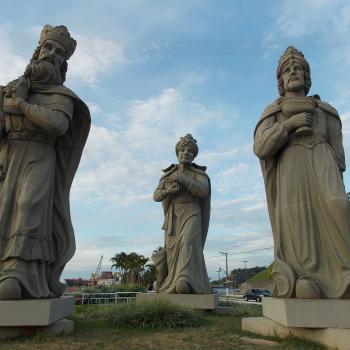 I’ve never seen a St. Francis statue like the one that sits in our back yard amidst the periwinkle, under the embrace of the Loving Tree. He doesn’t look anything like the one I’ve posted here. My St. Francis is a bit alarming. His super-sized hands hold a bird that, despite its stone composition, fairly shudders as though he’s about to be throttled. And Francis’ face is nothing short of mean. He scowls and squints, and his chin is lowered as though he’s peering over spectacles. He was a gift.
I’ve never seen a St. Francis statue like the one that sits in our back yard amidst the periwinkle, under the embrace of the Loving Tree. He doesn’t look anything like the one I’ve posted here. My St. Francis is a bit alarming. His super-sized hands hold a bird that, despite its stone composition, fairly shudders as though he’s about to be throttled. And Francis’ face is nothing short of mean. He scowls and squints, and his chin is lowered as though he’s peering over spectacles. He was a gift.
I admit to some dismay when I first saw it. Seriously? A grimacing St. Francis? Isn’t that an incongruence to the point of sacrilege? But I’ve grown to love this bold, cold, grumpy saint. I love the way he opens up sainthood and shatters the icky gloss of perfection.
Sometimes in my Church History classes, I get a few students who are really honest about their expectations. They want a nice, tidy, inspiring story about the history of the Church—a story that starts with the Ascension, proceeds very powerfully and righteously through the Apostolic years, triumphs through the dark chaos of the Middle Ages, lollops through the Reformation years with saintly glee, and emerges in 20th century America in the rush to the altar at a Billy Graham Crusade. (That’s what the Crusades are, right?)
And then I proceed to tell them a long story about the Church that is rife with great faith and great nastiness, unbelievable self-sacrifice, appalling cruelty, acts of grace, boneheaded leadership, windows into heaven, the outpouring of Spirit, pettiness, purity, and passion. All jumbled up, not nicely categorized by denomination. This can be shocking. I try to be nice about it. I try to show them how it isn’t the perfection of the Church that makes me love it, and it isn’t our wondrous ways that compel divine admiration and acceptance.
Lately I’ve been reading a book by von Balthasar about the saint of the Little Way, Thérèse of Lisieux. It’s not really a biography, but a deep analysis of her “sainthood.” In it, the author opens Thérèse’s soul to close inspection, peeling back layer after layer of culture, language, childhood events, relationships, understanding of scripture and theology, and spirituality. Sometimes it feels like he’s pulling back the proverbial Oz curtain to uncover weird manipulations, and then the manipulations themselves are pulled back to reveal a deeper, wilder spiritual vitality. In some ways Thérèse was a messed-up kid; in other ways, Thérèse was one of the most extraordinary strong-willed characters I’ve ever “met.” Thérèse willed one thing: the will of the Lord. She, more than nearly any saint I’ve read about, took to heart Paul’s counsel to “put to death” the desires of the flesh. For her, of course, this wasn’t about asceticism, but about willing the love of God and the fullness of the character of Christ, leaving behind the oh-so-innocent self-indulgences that cater to our own wills.
Von Balthasar’s book is not a hagiography. A hagiography is a biographical sketch of a saint that gushes, that idealizes the person and magnifies his or her godliness to the point that the human element fades into the background. Hagiographies have their place. Hagiographies can shed a bright light on some quite excellent virtue in such a way that the virtue itself becomes more tangible, and thus the center of our meditation.
But hagiographies can also be treacherous when they themselves do not recognize that they’re hagiographies, when they profess to tell the whole truth and nothing but the truth about the saint, and that that truth is wholly and entirely aglow with glory, purity, and seamless perfection. Such tales mislead. For the greatest saints in the world (and while I’m clearly not speaking from experience here, I feel quite sure of this) are mixed bags: rife with great faith and great nastiness, unbelievable self-sacrifice, appalling cruelty, acts of grace, boneheaded leadership, windows into heaven, the outpouring of Spirit, pettiness, purity, and passion.
Every 1 November, we sing “I Sing a Song of the Saints of God,” a lovely hymn about how the saints are hidden among us, disguised as ordinary people. And each stanza ends with a declaration of intent: I mean to be one, too.
Understanding something about the complexity of godliness encourages me.
St. Francis—saint of joy, simplicity, humility, and honesty… and scowling like Scrooge himself. Perfect.
I sing a song of the saints of God,
Patient and brave and true,
Who toiled and fought and lived and died
For the Lord they loved and knew.
And one was a doctor, and one was a queen,
And one was a shepherdess on the green;
They were all of them saints of God, and I mean,
God helping, to be one too.
They loved their Lord so dear, so dear,
And his love made them strong;
And they followed the right for Jesus’ sake
The whole of their good lives long.
And one was a soldier, and one was a priest,
And one was slain by a fierce wild beast;
And there’s not any reason, no, not the least,
Why I shouldn’t be one too.
They lived not only in ages past,
There are hundreds of thousands still.
The world is bright with the joyous saints
Who love to do Jesus’ will.
You can meet them in school, or in lanes, or at sea,
In church, or in trains, or in shops, or at tea;
For the saints of God are just folk like me,
And I mean to be one too.












